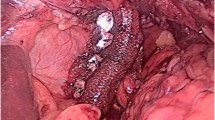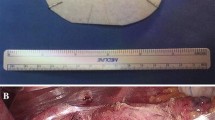Abstract
Background
The use of prosthetic materials for the repair of paraesophageal hiatal hernia (PEH) may lead to esophageal stricture and perforation. High recurrence rates after primary repair have led surgeons to explore other options, including various bioprostheses. However, the long-term effects of these newer materials when placed at the esophageal hiatus are unknown. This study assessed the anatomic and histologic characteristics 1 year after PEH repair using a U-shaped configuration of commercially available small intestinal submucosa (SIS) mesh in a canine model.
Methods
Six dogs underwent laparoscopic PEH repair with SIS mesh 4 weeks after thoracoscopic creation of PEH. When the six dogs were sacrificed 12 months later, endoscopy and barium x-ray were performed, and biopsies of the esophagus and crura were obtained.
Results
The mean weight of the dogs 1 year after surgery was identical to their entry weight. No dog had gross dysphagia, evidence of esophageal stricture, or reherniation. At sacrifice, the biomaterial was not identifiable grossly. Biopsies of the hiatal region showed fibrosis as well as muscle fiber proliferation and regeneration. No dog had erosion of the mesh into the esophagus.
Conclusions
This reproducible canine model of PEH formation and repair did not result in erosion of SIS mesh into the esophagus or in stricture formation. Native muscle ingrowth was noted 1 year after placement of the biomaterial. According to the findings, SIS may provide a scaffold for ingrowth of crural muscle and a durable repair of PEH over the long term.







Similar content being viewed by others
References
Williamson WA, Ellis FH, Streitz JM, Shahian KS (1993) Paraesophageal hiatal hernia: is an antireflux procedure necessary? Ann Thorac Surg 56: 447–452
Ellis FH, Crozer RE, Shea JA (1986) Paraesophageal hiatus hernia. Arch Surg 121: 416–420
Wu JS, Dunnegan DL, Soper NJ (1999) Clinical and radiologic assessment of laparoscopic paraesophageal hernia repair. Surg Endosc 13: 497–502
Hashemi M, Peters JH, DeMeester TR, Huprich JE, Quek M, Hagen JA, Crookes PF, Theisen J, DeMeester SR, Sillin LF, Bremner CG (2000) Laparoscopic repair of large type III hiatal hernia: objective follow-up reveals high recurrence rate. J Am Coll Surg 190: 553–560
Diaz S, Brunt LM, Klingensmith ME, Frisella PM, Soper NJ (2003) Laparoscopic paraesophageal hernia repair, a challenging operation: medium-term outcome of 116 patients. J Gastrointest Surg 7: 59–66
Edelman DS (1995) Laparoscopic paraesophageal hernia repair with mesh. Surg Laparosc Endosc 5: 32–37
Frantzides CT, Carlson MA (1997) Prosthetic reinforcement of posterior cruroplasty during laparoscopic hiatal herniorrhaphy. Surg Endo 11: 769–771
Frantzides CT, Richards CG, Carlson MA (1999) Laparoscopic repair of large hiatal hernia with polytetrafluoroethylene. Surg Endosc 13: 906–908
Pitcher DE, Curet MJ, Martin DT, Vogt DM, Mason J, Usaf M, Zucker K (1995) Successful laparoscopic repair of paraesophageal hernia. Arch Surg 130: 590–596
Willekes CL, Edoga JK, Frezza EE (1996) Laparoscopic repair of paraesophageal hernia. Ann Surg 225: 31–38
Wu JS, Dunnegan DL, Soper NJ (1999) Clinical and radiologic assessment of laparoscopic paraesophageal hernia repair. Surg Endosc 13: 497–502
Schneider R, Herrington JL Jr, Granda AM (1999) Marlex mesh in repair of a diaphragmatic defect later eroding into the distal esophagus and stomach. Am Surg; 45: 337–339
Oelschlager BK, Barreca M, Chang L, Pellegrini CA (2003) The use of small intestine submucosa in the repair of paraesophageal hernias: initial observations of a new technique. Am J Surg 186: 4–8
Halpin V, Meyers BF, Luttmann D, Frisella P, Meininger T, Soper NJ (2002) Laparoscopic paraesophageal hernia repair using prosthetics in a canine model. Surg Endosc 16(Suppl 1): S977
Santora TA, Roslyn JJ (1993) Incisional hernia. Surg Clin North Am 73: 557–570
Kurzer M, Belsham PA, Kark AE (2003) The Lichtenstein repair for groin hernias. Surg Clin North Am 83: 1099–1117
Champion JK, Rock D (2003) Laparoscopic mesh cruroplasty for large paraesophageal hernias. Surg Endosc 17: 551–553
Keidar A, Szold A (2003) Laparoscopic repair of paraesophageal hernia with selective use of mesh. Surg Laparosc Endosc Percutan Tech 13: 149–154
Frantzides CT, Madan AK, Carlson MA, Stavropoulos GP (2002) A prospective, randomized trial of laparoscopic polytetrafluoroethylene (PTFE) patch repair vs simple cruroplasty for large hiatal hernia. Arch Surg 137: 649–652
Prevel CD, Eppley BL, Summerlin DJ, Jack JR, McCarty M, Badylak SF (1995) Small intestinal submucosa: use in repair of rodent abdominal wall defects. Ann Plast Surg 35: 374
Clarke KM, Lantz GC, Salisbury SK, Badylak SF, Hiles MC, Voytik SL (1996) Intestine submucosa and polypropylene mesh for abdominal wall repair in dogs. J Surg Res 60: 107
Abraham GA, Murray J, Billiar K, Sullivan SJ (2000) Evaluation of the porcine intestinal collagen layer as a biomaterial. J Biomed Mater Res 51: 442
Gloeckner DC, Sacks MS, Billiar KL, Bachrach N (2000) Mechanical evaluation and design of a multilayered collagenous repair biomaterial. J Biomed Mater Res 52: 365
Badylak S, Kokini K, Tullius B, Whitson B (1998) Strength over time of a resorbable bioscaffold for body wall repair device in a dog model. J Surg Res 99: 282–287
Badylak S, Kokini K, Tullius B, Simmons-Byrd A, Morff R (2002) Morphologic study of small intestinal submucosa as a body wall repair device. J Surg Res 103: 190–202
Acknowledgments
The authors received an educational grant from Cook Biotech Inc. and support from Washington University Institute for Minimally Invasive Surgery (WUIMIS).
Author information
Authors and Affiliations
Corresponding author
Additional information
Presented at the annual meeting of the Society of American Gastrointestinal Endoscopic Surgeons (SAGES), Denver, Colorado, 3 April 2004
Rights and permissions
About this article
Cite this article
Desai, K.M., Diaz, S., Dorward, I.G. et al. Histologic results 1 year after bioprosthetic repair of paraesophageal hernia in a canine model. Surg Endosc 20, 1693–1697 (2006). https://doi.org/10.1007/s00464-006-0680-5
Published:
Issue Date:
DOI: https://doi.org/10.1007/s00464-006-0680-5




